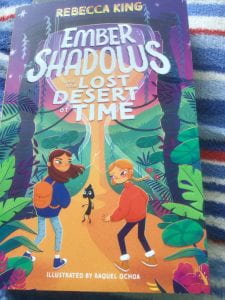 Most of us assume that we have a right to self-determination and the idea that we are restricted by a fate that is given to us at birth, is something that we might have real problems with. This is the idea behind the adventures of the feisty Ember Shadows. In the first book she is looking forward to receiving her fate card, which will decide if she can follow her dream of being an inventor; however, things do not happen as she hopes. Firstly, there is no fate written on her card and then her younger sister receives her card, saying that she only has a short while to live. This leads to a fantastic adventure as Ember tries to change the way that the fates work.
Most of us assume that we have a right to self-determination and the idea that we are restricted by a fate that is given to us at birth, is something that we might have real problems with. This is the idea behind the adventures of the feisty Ember Shadows. In the first book she is looking forward to receiving her fate card, which will decide if she can follow her dream of being an inventor; however, things do not happen as she hopes. Firstly, there is no fate written on her card and then her younger sister receives her card, saying that she only has a short while to live. This leads to a fantastic adventure as Ember tries to change the way that the fates work.
Thankfully the second book sees our heroine very much alive, as is her sister Juniper. At the end of the first book Ember manages to solve the riddle of the fate cards and gives everyone back the freedom to choose; however, for many people, especially the adult this is proving to be a very difficult option. There had been safety in the old system and they have problems coping with having choice. Someone is taking this fear to an extreme and they are gathering the strands of fate and cutting them, so that the owners are killed. Ember and her brilliant sidekick Hans (yes, he is a hand from a clock, brought to life by magic) decide that they need to try and stop any further disasters taking place. They meet a wide variety of characters on the way, from giant spiders to mon-keys (who manage the weather patterns), but there is always the lurking menace of the line cutter. The author manages to throw a lot of red herrings in our path and especially in Ember’s way, so that she is often caught out in her thinking about the culprit. The denouement sees an unexpected villain and an upsetting discovery about someone she had thought was a friend.
safety in the old system and they have problems coping with having choice. Someone is taking this fear to an extreme and they are gathering the strands of fate and cutting them, so that the owners are killed. Ember and her brilliant sidekick Hans (yes, he is a hand from a clock, brought to life by magic) decide that they need to try and stop any further disasters taking place. They meet a wide variety of characters on the way, from giant spiders to mon-keys (who manage the weather patterns), but there is always the lurking menace of the line cutter. The author manages to throw a lot of red herrings in our path and especially in Ember’s way, so that she is often caught out in her thinking about the culprit. The denouement sees an unexpected villain and an upsetting discovery about someone she had thought was a friend.
I absolutely love the main theme of this book , about letting people make their own decisions and allowing ourselves to make mistakes, learn from them and then try again. These are very important life lessons and together with the thoughts around family (and what that really means) there is a lot to make us think and to act s a start from some very important discussions. However, there is also a theme around Ember’s love of inventing and this is such an important message to be passing on to young girls especially today. Science and Engineering are equally as important for girls and boys, yet we still have a conscious or unconscious bias against this choice. This really is a superb series for the middle grade and I can’t wait for book three to appear next year. A five star series.
About the author
Rebecca King was born in Wolverhampton and spent her childhood in a
village called Sound in Cheshire.
She studied Journalism at the University of Portsmouth and has worked
as a reporter and a primary school teacher, including three years
teaching in China. She was inspired to write Ember Shadows and the
Fates of Mount Never after visiting Mount Everest, in search of her
Tibetan heritage.
She now lives in Bratislava, Slovakia, with her partner and her Chinese
rescue dog, Mushu.
